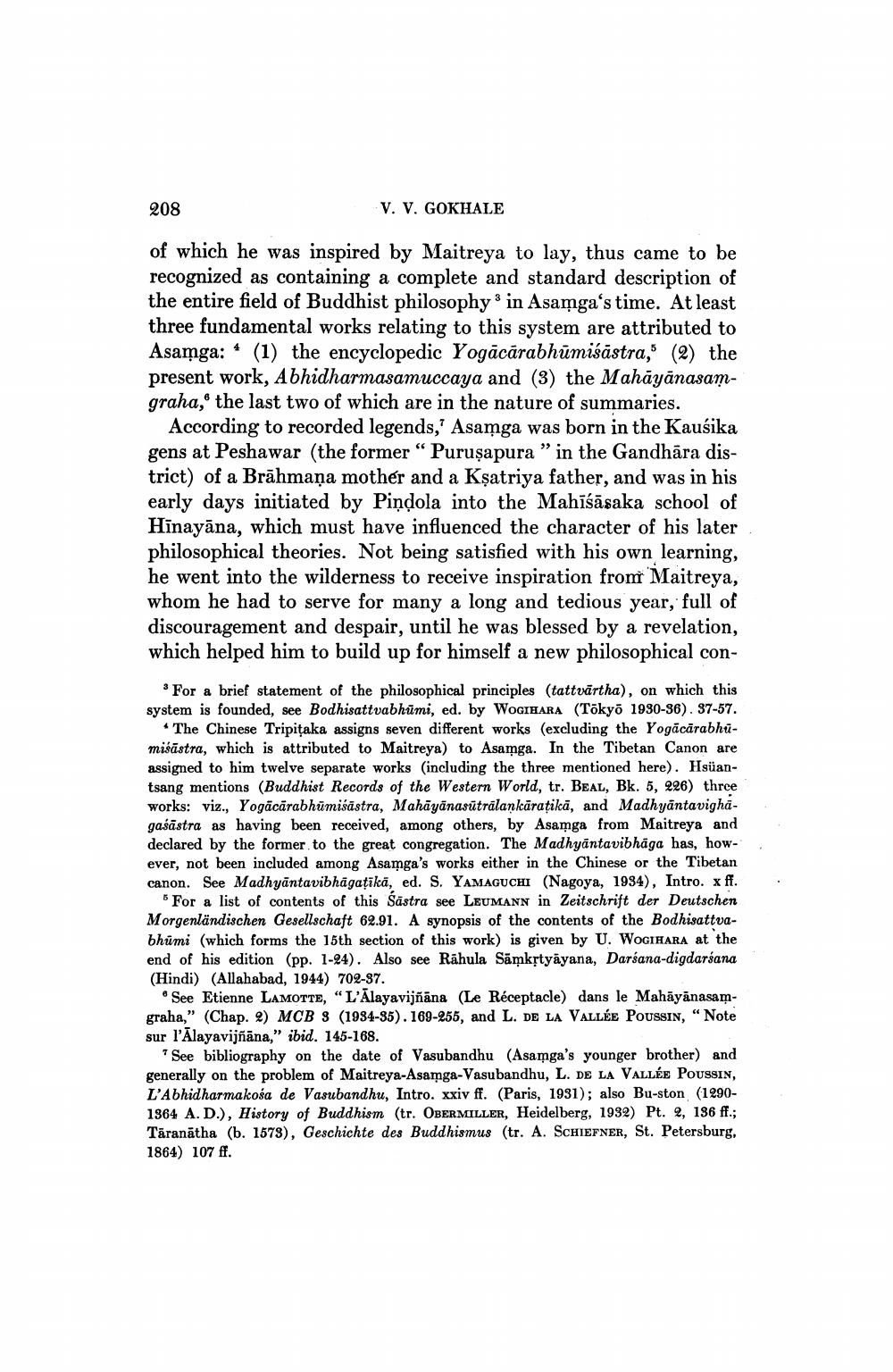Book Title: Rare Mmanuscript Of Asamgas Abhidharma Samuccaya Author(s): V V Gokhale Publisher: V V Gokhale View full book textPage 2
________________ 208 V. V. GOKHALE of which he was inspired by Maitreya to lay, thus came to be recognized as containing a complete and standard description of the entire field of Buddhist philosophy in Asamga's time. At least three fundamental works relating to this system are attributed to Asamga: * (1) the encyclopedic Yogācārabhūmiśāstra, (2) the present work, Abhidharmasamuccaya and (3) the Mahāyānasamgraha, the last two of which are in the nature of summaries. According to recorded legends, Asamga was born in the Kausika gens at Peshawar (the former “Puruşapura "in the Gandhāra district) of a Brāhmaṇa mother and a Ksatriya father, and was in his early days initiated by Piņņola into the Mahīśāsaka school of Hinayāna, which must have influenced the character of his later philosophical theories. Not being satisfied with his own learning, he went into the wilderness to receive inspiration from Maitreya, whom he had to serve for many a long and tedious year, full of discouragement and despair, until he was blessed by a revelation, which helped him to build up for himself a new philosophical con *For a brief statement of the philosophical principles (tattvārtha), on which this system is founded, see Bodhisattvabhūmi, ed. by WOGIHARA (Tokyo 1930-36). 37-57. The Chinese Tripitaka assigns seven different works (excluding the Yogācārabhumiśāstra, which is attributed to Maitreya) to Asamga. In the Tibetan Canon are assigned to him twelve separate works (including the three mentioned here). Hsüantsang mentions (Buddhist Records of the Western World, tr. BEAL, Bk. 5, 226) three works: viz., Yogācārabhūmiśāstra, Mahāyānasūtrålankāraţikā, and Madhyāntavighagaśāstra as having been received, among others, by Asamga from Maitreya and declared by the former to the great congregation. The Madhyantavibhäga has, however, not been included among Asamga's works either in the Chinese or the Tibetan canon. See Madhyāntavibhāgatīkā, ed. S. YAMAGUCHI (Nagoya, 1994), Intro. x ff. For a list of contents of this Šāstra see LEUMANN in Zeitschrift der Deutschen Morgenländischen Gesellschaft 62.91. A synopsis of the contents of the Bodhisattvabhumi (which forms the 15th section of this work) is given by U. WOGIHARA at the end of his edition (pp. 1-24). Also see Rāhula Sāņkrtyāyana, Darśana-digdarsana (Hindi) (Allahabad, 1944) 702-37. See Etienne LAMOTTE, "L'Alayavijñāna (Le Réceptacle) dans le Mahāyānasamgraha," (Chap. 2) MCB S (1984-85). 169-255, and L. DE LA VALLÉE POUSSIN, "Note sur l'Alayavijñāna," ibid. 145-168. See bibliography on the date of Vasubandhu (Asamga's younger brother) and generally on the problem of Maitreya-Asamga-Vasubandhu, L. DE LA VALLÉE POUSSIN, L'Abhidharmakośa de Vasubandhu, Intro. xxiv ff. (Paris, 1931); also Bu-ston (12901364 A.D.), History of Buddhism (tr. OBERMILLER, Heidelberg, 1932) Pt. 2, 136 ff.; Tāranātha (b. 1573), Geschichte des Buddhismus (tr. A. SCHIEFNER, St. Petersburg, 1864) 107 ff.Page Navigation
1 2 3 4 5 6 7
